Neem oil is an effective, all-natural insecticide, and it’s great for controlling and repelling bugs that eat your plants. You can use it both indoors on your houseplants or outside in the garden.
Not only does it work to prevent pest infestations, you can also use it to control disease and fungus outbreaks. I’ve been using it for decades, so I know first had just how much of a game changer it is. Trust me, it will be your new best friend!
In this post I will tell you all you need to know, and show you how to use neem oil on your plants. You’ll learn exactly what it is, which pests and diseases it works on, when, how much, and how often to apply it, and I’ll even show you how to make your own spray using my easy recipe.
The oil is extracted from the tree seeds, and is either sold in its pure form, or mixed with other ingredients to make pesticide and fungicide sprays.
It is not a poison, and it’s non-toxic to humans, cats, and dogs, so it’s safe to use both indoors and outdoors. That’s why it’s also commonly used in beauty and health care products.
How Does Neem Oil Work?
Basically, the way it works as a pesticide is that it messes with the brains and hormones of the bugs that eat it. It causes them to stop feeding and mating, and they will eventually die off. It also works to smother them on contact, which kills them faster.
In addition to killing insect pests, neem oil repels them, and it has a slight residual effect to keep them away longer than other organic methods.
The best part is that it only kills the ones that eat plants, so it won’t harm beneficial insects (as long as you don’t spray it directly on them).
Neem oil won’t kill all of the bugs on contact, so it might take a few days, weeks, or even months for them to disappear from the plant completely.
Other Neem Oil Uses For Plants
Beside using it to control pests, neem oil also works as a fungicide, so it can help prevent and fight plant diseases. It doesn’t cure them, but it stops them from getting worse.
The way it works is it prevents the spores from spreading. So it won’t always completely eliminate the fungus or disease, but it can reduce the spread so your plant will be able to keep growing. Here are some common ones it works on:
- Powdery mildew
- Blackspot
- Rust
- Leaf spot
- Blight
- …and more
Related Post: How To Debug Plants Before Bringing Them Indoors
What Kind Of Bugs Does Neem Oil Kill?
Neem oil works to kill all types of houseplant bugs, and it has helped me get rid of every single one I’ve ever dealt with. It also works to control destructive plant-eating garden pests outside. Here are a few examples:
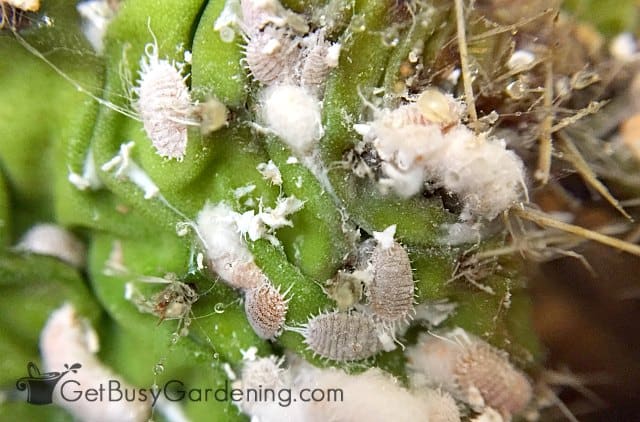
Precautions
While it’s not harmful to furry pets or humans, there are a couple of precautions you should take before using neem oil on your plants:
- Some plants are sensitive – Though it’s not very common, some plants are sensitive to any type of sprays, even neem oil. So always test it on one or two leaves and let it sit for 24 hours to make sure it doesn’t damage them.
- Use caution around beneficial bugs – Please remember that all forms of pesticides, including natural ones, should be used with care. Always follow the instructions on the label, and never spray it directly on or nearby any beneficial insects.
- Don’t use it around fish – It can be toxic to fish and amphibians, so don’t use it around a pond, fish tank, or other areas where these creatures live.
- Be careful what you buy – Some brands sell neem oil products with lots of other chemicals mixed in. So always be sure to read the label, because some of the additives can be much more toxic, and are not made for organic gardening.
How To Make Neem Oil Spray For Plants
You can buy neem oil based pesticides in pre-made sprays, or you can make your own using a pure organic concentrate for plants.
I prefer to make my own because I can control the ingredients, so I know there’s no chemicals or harsh ingredients mixed in. Here’s my recipe and instructions:
My Neem Oil Spray Recipe
- 1 ½ teaspoons pure organic neem oil concentrate
- 1 teaspoon mild liquid soap*
- 1 liter tepid water
Mixing Instructions
If you bought a different brand of pure neem oil concentrate than what I’ve listed above, read the label to make sure there aren’t any special directions for mixing it.
To make my recipe, mix all of the ingredients into a spray bottle and shake well. You can use it on your plants right away, or it will last for a few weeks in the bottle. Be sure to shake it well each time you use it.
*The soap helps the oil mix with water, since they don’t mix well on their own, so don’t skip it. It also has the added benefit of killing bugs on contact, so you should start seeing an improvement right away.
How To Use Neem Oil On Plants
It’s easy to use neem oil on your indoor or outdoor plants, but it’s important to know the right time to apply it, as well as how to do it for the best results.
Below I will discuss exactly when and how to spray it, and give you step by step instructions.
When To Spray Neem Oil
It doesn’t matter when you use it indoors on your houseplants, you can apply it any time of the year, day or night.
But outdoors, it’s best to use it either in the early morning or late evening so you don’t have to worry so much about harming beneficial bugs.
Also, don’t apply it in the full sun, because neem oil can make the leaves more sensitive to sunburn.
So if you can’t spray it in the morning or move your plant to the shade, then do it on a cloudy day. Once it’s dry it will no longer pose a threat.
How To Apply Neem Oil
Applying neem oil to your plants is pretty straight forward, but you should follow these steps so that you do it the right way:
- Test it on a leaf or two to make sure there’s no damage before using it on the whole plant.
- Spray the entire plant with, getting both the top and bottom of the leaves.
- Keep the plant out of direct sunlight until the leaves are dry.
- Continue to use neem oil every week until you no longer see any signs of the bugs or disease.
Additional Tips For Applying Neem Oil
I wanted to mention a few other key tips about applying neem oil on your plants so that you will have the best possible success using it. Here are some additional pointers:
- For best results, be sure to douse your plant until it’s dripping wet, and get into every nook and cranny that you can.
- I recommend moving houseplants to a shower or sink, or outside if it’s warm enough, to avoid making a mess indoors.
- It’s not likely that you’ll get rid of an insect pest infestation with one application, so you have to be persistent.
- You can also use neem oil as a drench to kill annoying bugs in the soil as well, just take care not to overwater your plant in the process.
Related Post: Fungus Gnats vs Fruit Flies: What’s The Difference?
How Often To Apply Neem Oil
You should spray your plant with neem oil weekly until you no longer see any bugs. If you have one that’s plagued by recurring infestations, then use it monthly as a preventive treatment.
For fungus and disease control, it’s best to start applying it to your most susceptible plants at the beginning of the season, or as soon as you see symptoms. Then spray it weekly to stop the spread.
Remember that neem oil has a slight residual effect, so you don’t have to treat your plant every day like you would with other natural insect pest control methods.
FAQs
To me neem oil smells nutty. While it has a strong and distinct odor, it’s not unpleasant. But some people don’t like it, and they think it smells bad. So it may be different depending on the specific brand you buy. The aroma is short-lived and goes away once it dries.
How long does neem oil take to work?
It takes a few days for neem oil to start working once the bugs eat it. But it also smothers some of them on contact, so you should begin to see an improvement right away.
If you have never used neem oil to kill bugs on your plants, I highly recommend trying it. It’s by far one of the best natural pest control methods I’ve ever used.
If you’re struggling to keep bugs off your indoor plants, then my Houseplant Pest Control eBook is for you. It will show you how to identify which one is infesting your plant, and show you exactly how to get rid of it FOR GOOD! Download your copy today!
More About Houseplant Pests
Have you ever tried using neem oil on plants? Share your experiences in the comments below.
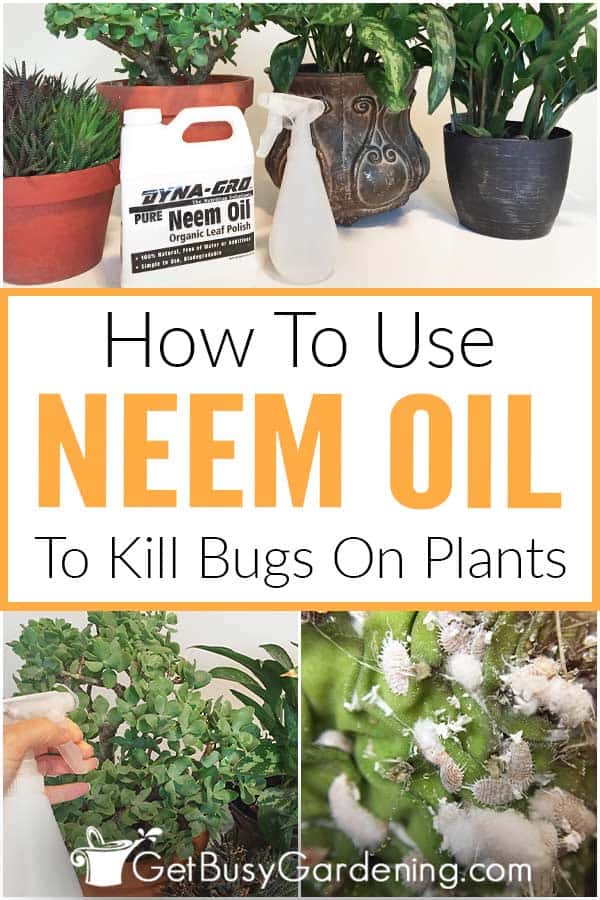
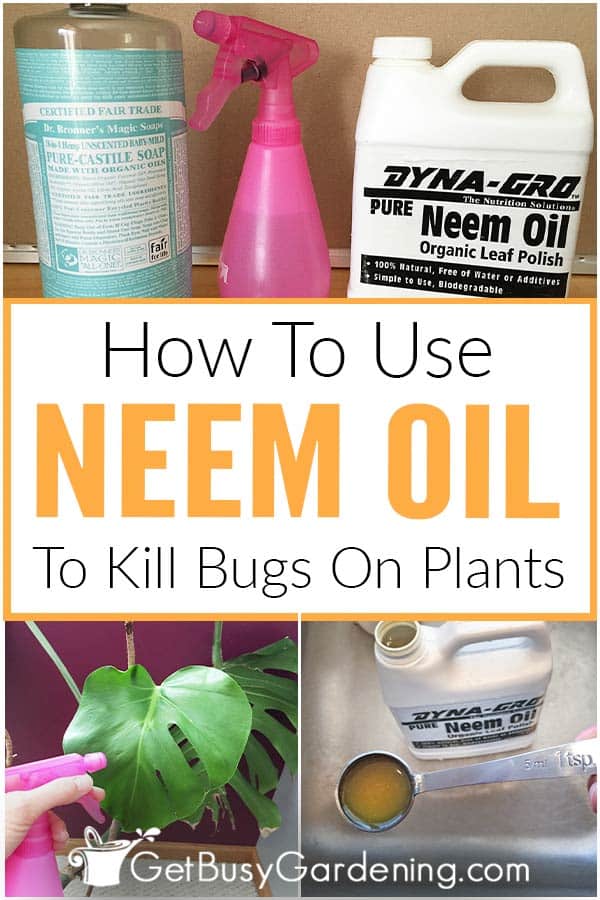

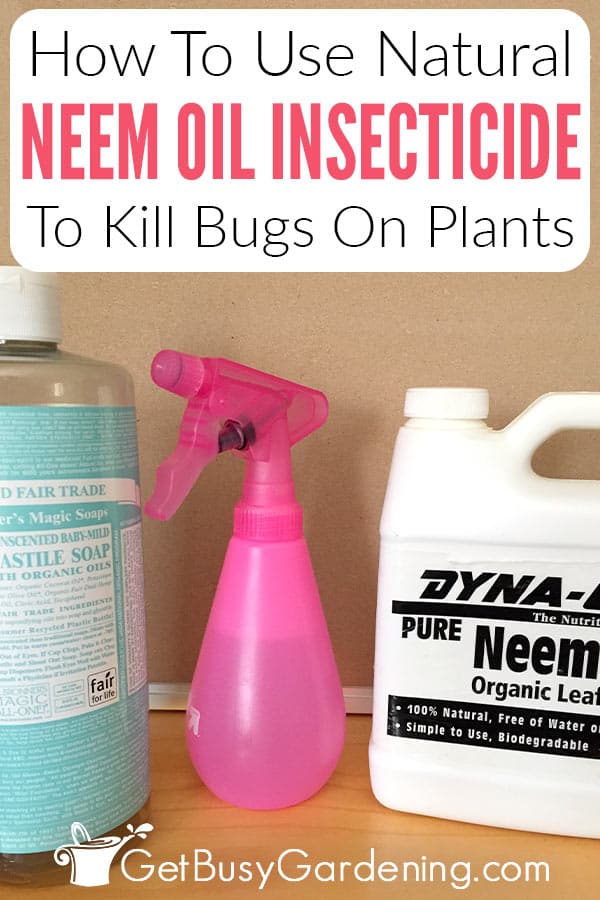
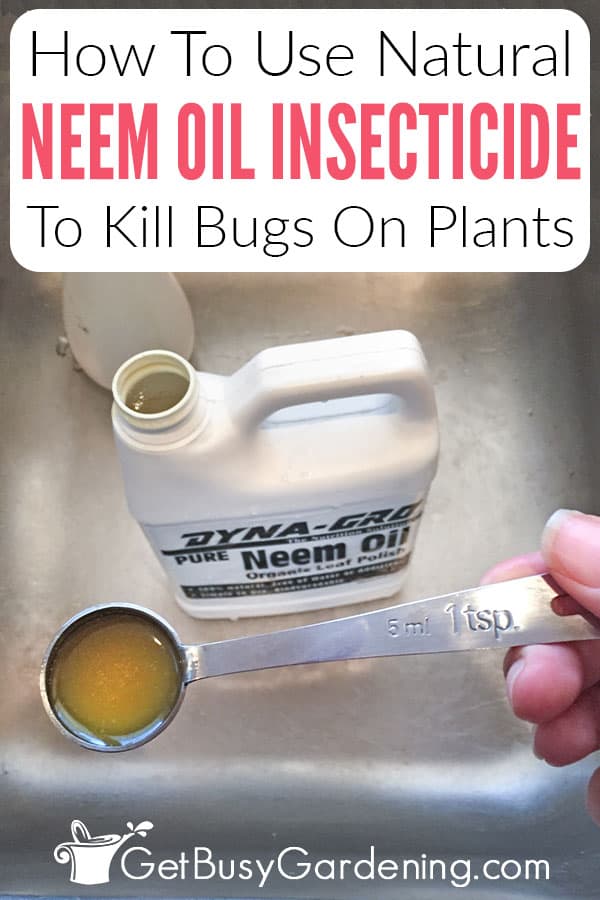
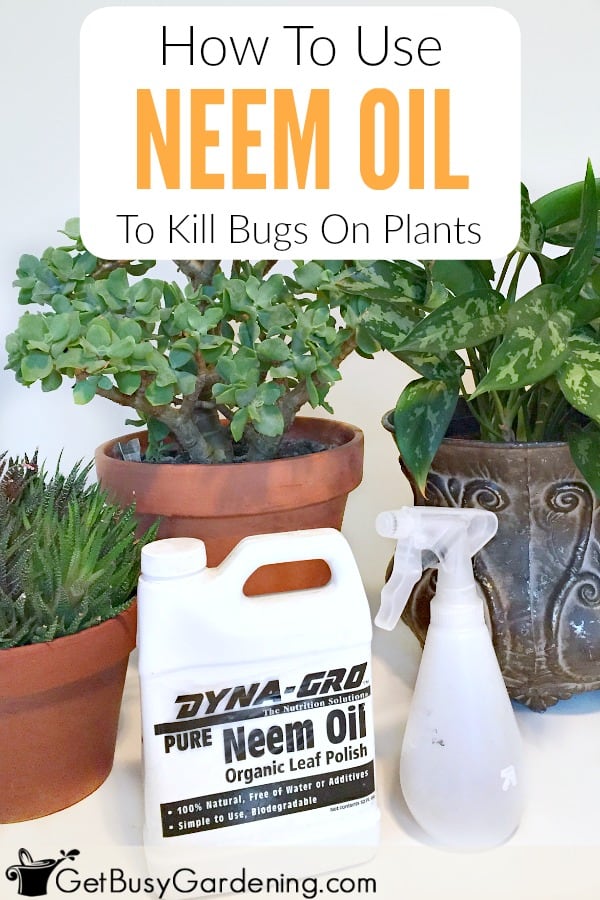
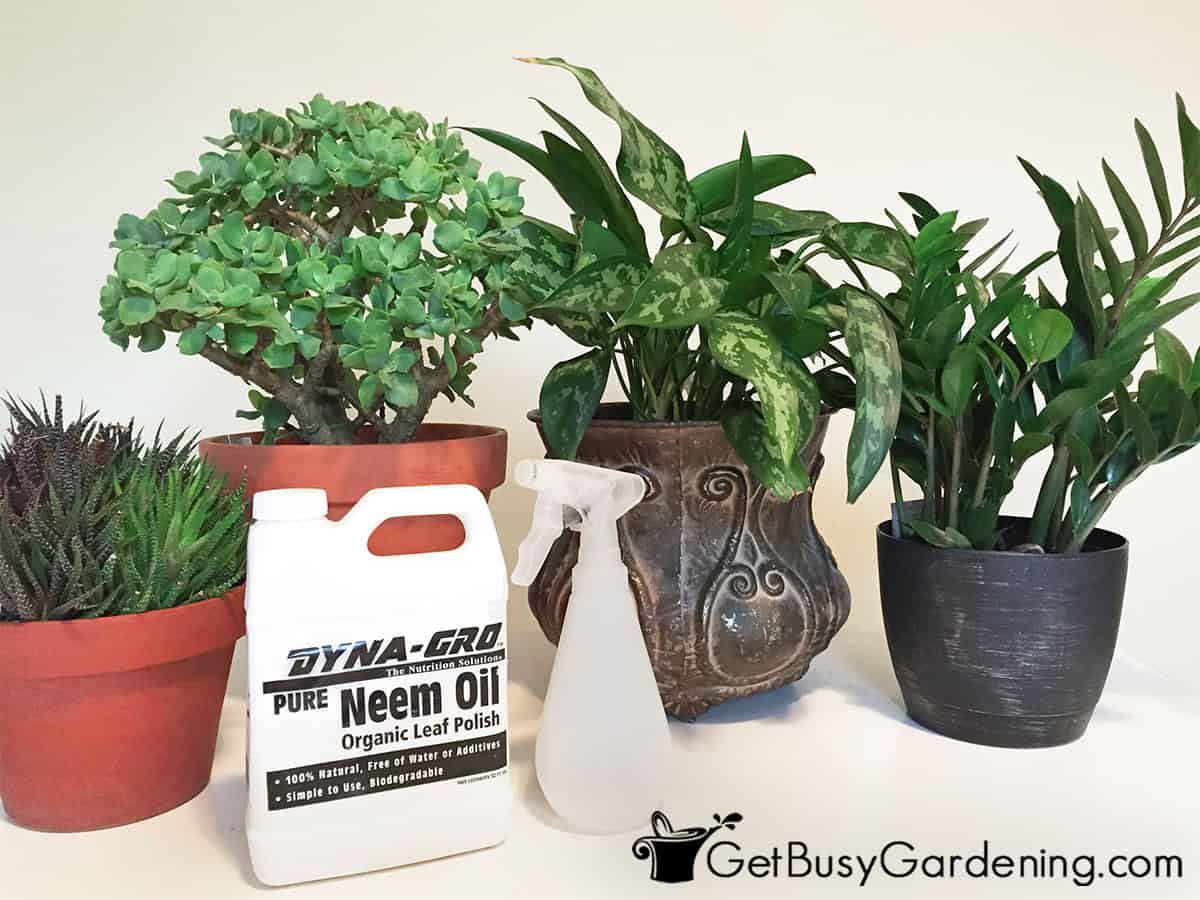

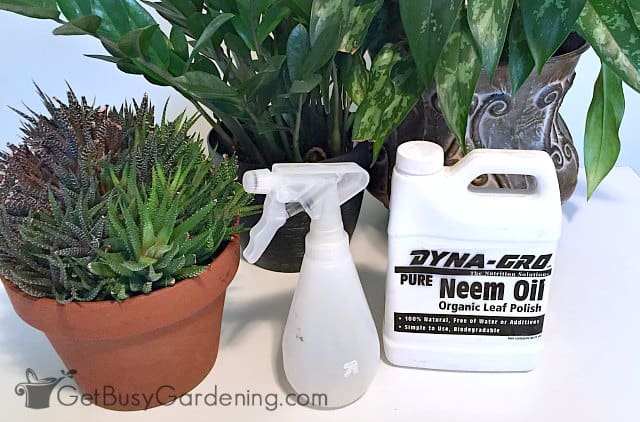
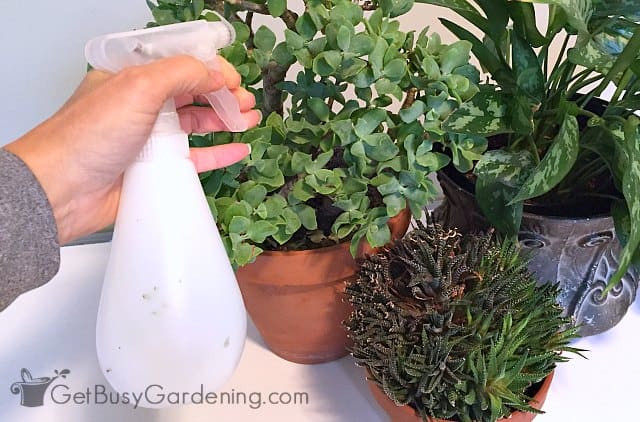
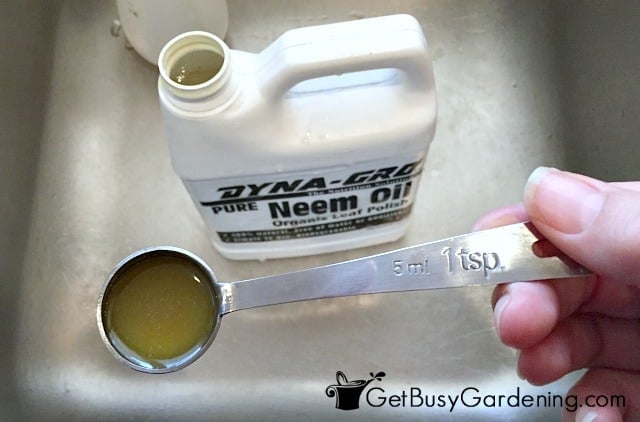

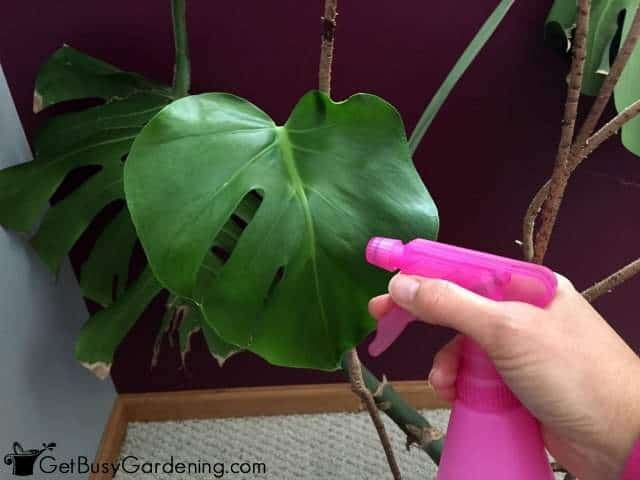
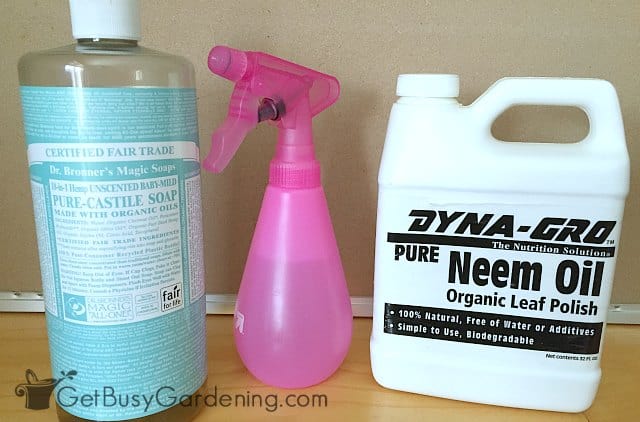
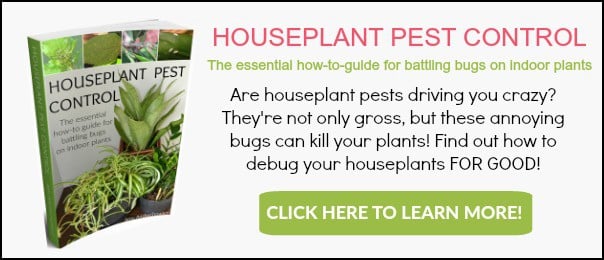

Helga Miller says
Hello Amy,
I have a mandarin tree that has been heavily infected with mealybugs for years. Last year I treated it outside with a heavy drenching of insecticidal soap and it looked like I killed it for good. I didn’t give up on it and brought it inside last fall. It slowly started growing again and it bloomed and started to set fruit again but the bugs are back. I saw some leaves yellow and getting chewed up and the white sticky bugs in the crooks and crevices. Can I spray this tree, that my family wanted thrown out, with the neem oil concoction? I’ve had this tree for almost ten years and I love it dearly! Thanks you!
Amy Andrychowicz says
Definitely test any type of spray on a few leaves before you treat the entire plant, to make sure it doesn’t cause any damage. Also, never spray a plant when it’s sitting in the full sun, that can cause major damage. But yes, if I were you, I would try testing the neem oil spray on a couple of leaves and let it sit for a few days to make sure they don’t drop off or burn. Then treat the whole plant, and keep it out of directly sunlight until the leaves are dry. Good luck!
Sarah says
You mentioned doing a soil drench to get rid of fungus gnats.. Do you use the same recipe as your DIY spray?
Amy Andrychowicz says
Yes, you can use my same neem oil mixture recipe as a soil drench.
Vicki Evans says
Happy to have found your site! I’m bringing in my house plants for the winter. Can you clarify for me about the insecticidal spray… is it combination of water, Neem oil AND castile soap? Not sure if it is all three or just the Neem oil & water. Also, just to make sure, the application is NOT rinsed off, right?
Thanks for clarifying!
Amy Andrychowicz says
Yes, the recipe includes all 3 ingredients. Neem oil and water won’t mix, you have to add the soap so the oil has something to bind to and so it can mix with the water. And you’re correct, do not rinse it off, let it dry on the plant.
Leonor Loya says
I have several Epiphyllum that have developed scale. I do have them outside. Would it harm them to be sprayed with the neem oil spray?
Amy Andrychowicz says
Whether neem oil spray will harm your epis or not totally depends on the type of plant. It’s always best to test it on a few leaves first and leave it on for a couple of days to make sure there’s no damage before treating the whole plant.
Faiza Aijaz says
Hi ,i have already used chemical pesticide for thrips infestation for my plants. Will neem oil still work to treat them? TIA
Amy Andrychowicz says
Yes, the neem oil will still work. I recommend you stop using the chemical pesticide and switch to only using the neem oil instead.
Janine says
Hi, I have large dracaenas that have a big spider mite infestation. They are indoors in Phoenix, AZ in large floor to ceiling, tinted, East windows. My plan is to take each one outside, early morning while cool, spray entire leaves til dripping.
Once dry, put back inside.
Repeat every 7 days til gone.
Afternoon temps are reaching 90-100.
Sun is off windows about noon.
Should this plan work?
Amy Andrychowicz says
You really shouldn’t need to apply the neem oil that often. You can give your plant a good dousing once, then reapply every few weeks after that if necessary. Definitely make sure to test the neem oil on a leaf first and let it sit for a few days before drenching the whole plant, as some can be sensitive to sprays.
Emma says
I am repotting three plants from one pot that has thrips, should I keep any of the soil?
Amy Andrychowicz says
If you haven’t already done it, I don’t recommend repotting plants that have an insect infestation. Repotting is very stressful for plants, and the shock can end up killing plants that are already stressed from the bug infestation. Instead, it’s best to get rid of the infestation first, and get the plant back to health before repotting. Here’s all the details for how to get rid of thrips on houseplants.
Sindi M Nalley says
I started using neem Max to get rid of those knat flying bugs that drive me and my plants CRAZY, and I have a couple questions, I live in Washington state, dark and rainy, so I keep grow lights on my plants and my question is, after spaying the neem, how long should I keep the grow lights off them, and, after spraying the plants, is that all I need to do , until next spray, just spray and go but on a weekly schedule. I’ve read but I’m just not getting it, not clear to me. Thank you for your time and help.
Amy Andrychowicz says
You can turn your grow lights back on once the neem oil has dried, so after the leaves are dry. Yes, that’s all you need to do until the next spray. The neem oil will work to kill the bugs that eat the leaves. You don’t need to spray weekly, as it has a residual effect. So a few times a month is plenty. Also, if those flying bugs you’re talking about are fungus gnats, then spraying the leaves won’t do much to get rid of them. They live and breed in the soil, so you’ll either need to use the neem oil as a soil drench, or try some other forms of control for them. Here’s all the information about how to get rid of fungus gnats.
Stella says
I have mealy bug and used the Neem Oil on my Money plants and they have lost most of their leaves is this normal??
Amy Andrychowicz says
No, it’s not normal for your plant to lose its leaves after treating it with neem oil. Some are very sensitive to sprays of any kind, so it’s always best to test it on a few leaves before treating the whole plant. But the dropping leaves could be from another cause, like improper watering, or from the damage from the bugs. But for now, I would stop spraying it to see if it will recover, and check to see if there’s some other cause for the dropping leaves. You can hand-treat the bugs until you figure it out, here’s more information about how to get rid of mealybugs.
Jodie Kearley says
I’ve been really struggling with a bad fungus gnat infestation and am hoping to try your neem oil and soap and water but I’m not too sure whether to spray the soil and the plant or one or the other? As you certainly know they are mostly found in the soil…
Jodie Kearley says
I should say it’s a mix of houseplants, succulents and cacti. Thanks 🙏
Amy Andrychowicz says
Definitely keep your neem oil treatments focused on the soil. Treating the plant will have no effect on them, since they don’t eat the leaves. You can add it to your watering can, so they get a dose each time you water. But be careful not to overwater, because that’s how they breed. Here’s a post with more information on how to get rid of them.
Kathy says
Will neem oil kill ants on plants
Amy Andrychowicz says
In order for neem oil to work, the bugs have to eat it. So, since ants don’t eat plants, it probably won’t work to kill them. Here’s an article about ants on plants, and tips for getting rid of them, if necessary.
Ariana says
Hi Amy!
I noticed my new monstera plant has a few bug on it. I want to start a treatment with neem oil and prepared the spray with the water and soap. At what frequency would you recommend spraying my plant with it?
Thank you!
Amy Andrychowicz says
The first thing to do is identify the bugs that are on your plant. That will make it easier to determine the best treatment plan, and ensure it will be the most effective. Since you only have a few bugs, I would treat the plant with neem oil monthly until all signs of them are gone. Once you get rid of them, then just monitor it closely to make sure they don’t come back.
Pat says
Hello, interesting articles. I would like to use neem oil on my orchid which has mealy bugs but I’m not sure if I’m interpreting the amounts in the formula correctly. Does 1 1/2 teaspoon mean 1×1/2 i.e. one half-teaspoon or does it mean one-and-a-half teaspoons i.e. 1.5 teaspoons. Since the latter is 3 times the amount of the former the difference could be important for some plants. Thanks for any clarification!
Amy Andrychowicz says
It is one-and-a-half teaspoons.
Mireya says
How much need oil do I use.
Amy Andrychowicz says
Check out my neem oil recipe above for the exact amount.
Teresa says
My ficus has sticky leaves and now my umbrella plant is getting it too. I think this is due to a bug of sometime. I have bought concentrated need oil. Before I use your recipe on the plants, is it best to wash off the sticky substance first, then spray? They are in my conservatory at the moment.
Amy Andrychowicz says
Yes, I always wash the leaves with an organic insecticidal soap first, which will kill many of the bugs, giving you the upper hand. Then I start treating regularly with neem oil until all signs of the bugs are gone. I recommend that you test both of these sprays on a few leaves first to make sure they won’t cause any damage before treating the whole plant. Here’s a post on how to ID the bugs… How To Identify Common Types Of Houseplant Bugs. Good luck!
Teresa says
Yes I cleaned the ficus and then sprayed the neem. I did this about 3 weeks ago and so far so good. I have sprayed the umbrella and the rest of my plants lightly all over the house. My spring flowers are coming up now and my tulips last year were full of aphids. When the heads start to appear, I will try a light spraying of them too.
Amy Andrychowicz says
Sounds like you’re doing the right things. Just make sure to be persistent with the neem treatments, as it takes time to get rid of a heavy infestation. Don’t give up, keep doing what you’re doing! 🙂
Nancy Starkweather says
I have been struggling with scale on my succulents, and a few other plants. Can neem oil kill scale with out killing the plants such as aloe or agave?
Amy Andrychowicz says
Sorry to hear you’re having bug problems on your plants, that’s no fun. Neem oil works great on most plants, but some are sensitive to any type of spray. The best way to know for sure is to test it on a leaf or two, and leave it for a week. If there’s no damage, then it’s safe to spray the whole plant. Good luck!